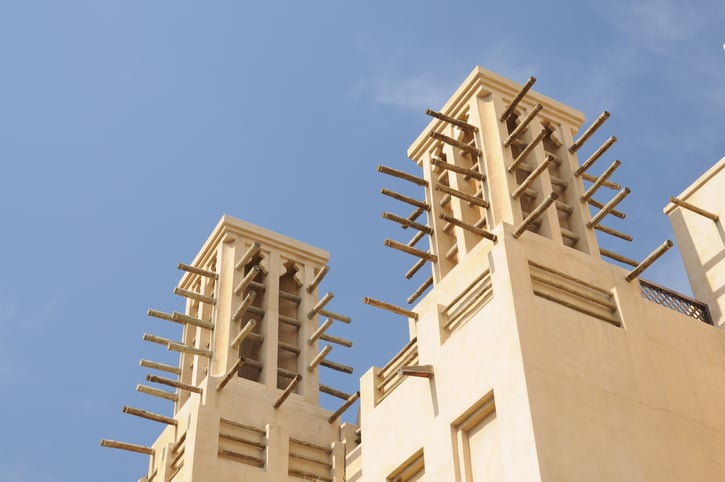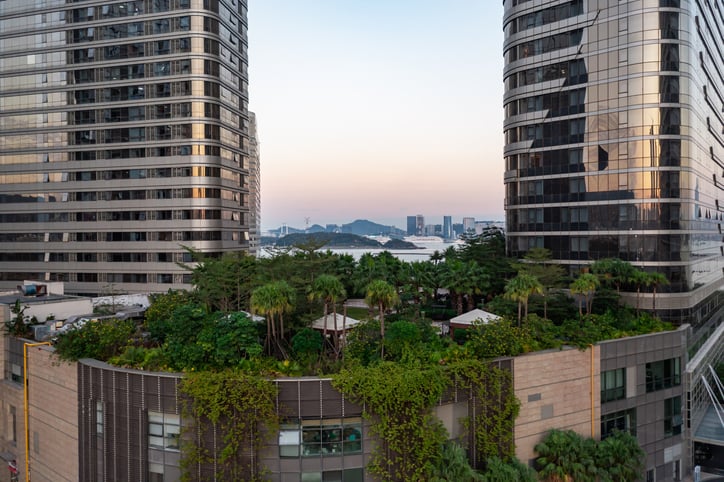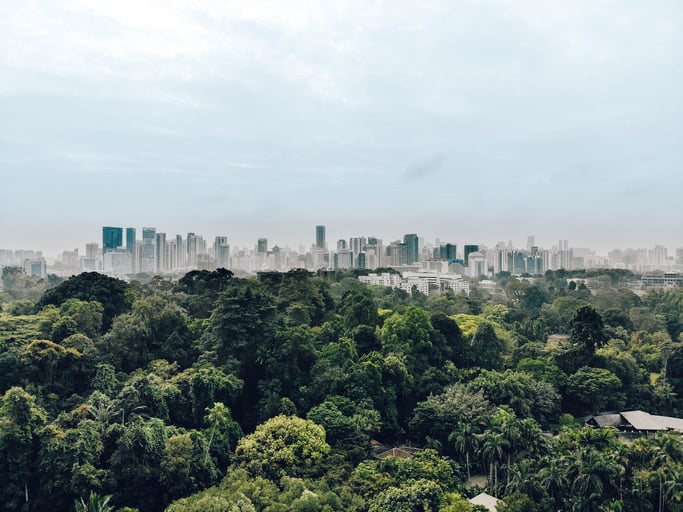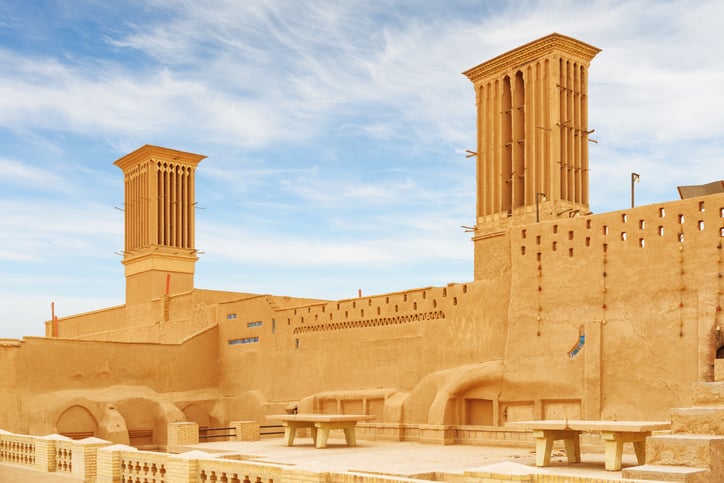
The Catch-22 of air conditioners is that they heat the outdoors while they cool the indoors.
This might not be such a big deal if it didn’t come at such a steep environmental and financial cost. The summers are getting hotter as a result of climate change and utility bills aren’t exactly getting cheaper. Air conditioners may be convenient, but we ignore the negative consequences of these power-hungry machines at our own peril.
In this article, we will explore some innovative, simple, low-tech, low-cost, sustainable cooling methods that offer a glimpse of what a less air-conditioned world might look like.
Jump Ahead:
- Why We Need Sustainable Alternatives to Air Conditioning
- Four Eco-Friendly Alternatives to Air Conditioning
- Green Roofs
- Trees
- Adiabatic Cooling
- Wind Catchers
Why we need sustainable alternatives to air conditioning
Air conditioners worsen the problem that they were created to solve.
There are roughly 2 billion air conditioner units running in the world today, according to an estimate by the International Energy Agency (IEA). Together, they consume about 10% of the globe’s total electricity, which—despite wind and solar being cheaper—is still generated predominantly by fossil fuels. Fossil fuels emit greenhouse gases that trap heat in the atmosphere. In addition to their carbon footprints, most air conditioners also emit hydro-fluorocarbons, a refrigerant that is thousands of times more damaging than CO2. Altogether, the direct and indirect emissions from air conditioners alone are projected to raise the global temperature by as much as half-a-degree by the end of this century, according to calculations by the World Economic Forum. What’s more, every individual air conditioner unit also emits hot air outside as it produces cold air inside, raising the ambient temperature of the outdoors by 1.8°F.
Besides worsening the climate crisis, air conditioning also isn’t cheap. The cost of electricity to American consumers surged more than 14% last year, and according a recent report in Forbes, air conditioning can cost anywhere from $1,200 to $4,000 per year, depending on the size of the space being cooled. Prices are likely to continue climbing as the planet gets hotter, driving up demand for air conditioning. To put this into perspective: the last eight years have been the warmest on record across the globe. As the heat continues to intensify, the IEA estimates that by 2050, the number of air conditioners in operation worldwide will nearly triple to 5.6 billion units.
This is the vicious cycle of the air conditioning paradigm: Air conditioners consume high amounts of electricity, emitting greenhouse gases that make the outside world hotter, which drives demand for more air conditioners, and so on.
How can we escape this cycle? Is there a way to cool the indoors without adding heat to the outdoors? Answering these questions begins with the realization that we do have options, that there are indeed other, more sustainable ways to cool our buildings and cities.
Four Eco-Friendly Alternatives to Air Conditioning
To beat the heat inside, we need to learn how to lower the heat outside.
All the cooling methods discussed below are low-tech, low-energy, and low-cost compared to air conditioning. While none purport to be able to replace air conditioners entirely, each of these eco-friendly alternatives has the potential to reduce our dependence on them, thereby softening our impact on the climate and easing the burden on our strained electrical grids.
Green Roofs
A green roof is a layer of vegetation that either partially or completely covers the top of a human-made structure.
Green roofs perform multiple functions and have numerous benefits from a sustainable construction perspective. For starters, they’re aesthetically pleasing, offering a verdant vista in place of the drab concrete, shingled, or tar-and-gravel rooftops that are characteristic of most modern buildings. With the proper plant-life, green roofs can also serve as lush gardens, providing a sustainable source of nutritious food to a building’s occupants. As mini-urban-ecosystems, green roofs can also promote biodiversity in the form of shelter and replenishment for pollinators and other organisms. Green roofs insulate buildings and increase their energy efficiency. They also purify the air and clean stormwater runoff.

Most importantly, green roofs are a highly effective way to lower the ambient temperature of our communities, potentially reducing our need for air conditioning. Heat absorbed during the day by all the concrete, steel, and asphalt that makeup our streets and buildings creates what’s called the heat island effect—a phenomenon that can raise the ambient temperatures of our cities by as much as 7°F.
We can begin to push back against the heat in our communities by installing green roofs, which can cool ambient outdoor temperatures by up to 5°F, according to the Environmental Protection Agency. Remarkably, the air temperature when standing on a green roof can also be as much as 30 to 40°F to cooler compared to conventional rooftops. Green roofs are so effective at regulating urban temperatures that the authors of a recent report by the Intergovernmental Panel on Climate Change stated with “very high confidence” that installing more of them is one of best things we can do to cool down our ever expanding cities.
Trees
One of the simplest, healthiest, and most sustainable ways to cool our homes and communities is to add more trees.
The fact that it’s cooler in the shade of a tree may seem painfully obvious, and yet this common knowledge is woefully under-utilized in practice. In fact, rather than adding more trees in preparation for ever-warmer climate conditions, American cities are actually removing them at the alarming rate of about 175,000 acres per year—equating to roughly 36 million trees lost on an annual basis, according to a 2018 report by the US Forest Service.

This is a mistake. Trees absorb carbon, clean the air, provide habitats for wildlife, and bolster mental and physical health. Tree shade also has enormous benefits for our streets, neighborhoods, and buildings. In a recent study, a team of Swiss researchers analyzed the land surface temperatures of 293 European cities. Their findings revealed that the cities with the most trees were as much as 21°F degrees cooler compared to places with sparse tree coverage. You may be surprised to learn that the cooling benefits of trees also affect the interiors of our buildings, potentially cutting the need for air conditioning in half: In another study by the US Forest Service, researchers showed that the shade from trees planted alongside a residential building in hot Sacramento, California reduced the structure’s annual air conditioner use by 47%.
If we want to change the air conditioning paradigm, we need to change how we think about the spaces we’re trying to keep cool. The deceptively simple truth that our behavior rarely reflects is that the temperature inside is directly connected to the temperature outside, and vice versa. With this in mind, it’s clear we should be planting and protecting trees instead of removing them.
Adiabatic Cooling
Adiabatic or evaporative cooling systems harness the natural phenomenon of evaporation to cool the surrounding air.
The word “adiabatic” is a thermodynamics term that describes how warm, moist air cools as it rises and expands, resulting in a decrease of ambient air temperature. Effective in low-humidity areas, adiabatic cooling systems work by drawing in hot air over a water-saturated pad or other medium. The water then evaporates, lowering the surrounding air temperature.
There are many different types of adiabatic cooling systems, ranging from low to relatively high-tech. The most common examples are evaporative or "swamp" coolers, which can be purchased at virtually any hardware store and are effective at cooling smaller interior spaces in drier climates by as much as 15 to 40°F for only a quarter of the energy used by air conditioners, according to the EPA. Like central air, large-scale adiabatic systems can also be used to cool entire buildings: Microsoft has sung the praises of adiabatic cooling as an effective method for lowering the temperature in data centers and a recent study explored the use of adiabatic systems for cooling off livestock.
Though still far more energy-efficient than air conditioners, all the above examples of adiabatic systems fall on the relatively high end of the technological spectrum. A fascinating example of a lower-tech adiabatic system for cooling outdoor spaces is a prototype bamboo tower in Hanoi, Vietnam designed by architecture and engineering firm AREP.
Designed in BIM, AREP built its five-meter-tall, hyperboloid-shaped tower entirely out of sustainably sourced bamboo and local recycled parts as a way to lower the project’s embodied carbon footprint. The vertical latticework of the bamboo frame was filled in with shorter, horizontally-oriented bamboo shoots to serve as the evaporative medium. A circular fountain on top trickles water down through the structure, while a fan (sourced from a local salvager) pulls in hot air from above and circulates the cooler air that results from evaporation outward. When tested, AREP’s innovative, low-tech adiabatic cooling tower reduced the nearby air temperature by a full 6 degrees.
Wind Catchers
Wind catchers are an ingenious cooling technique that originate in the hot arid climate of the Middle East. Their exact birthplace is the subject of debate, with historical evidence pointing to either Iran or Egypt. Whatever the case, we know wind catchers have been successfully used to cool structures in the high heat of the Arabian deserts for at least two thousand years.

Also referred to as wind towers, wind scoops, or bâdgir (بادگیر) in Persian, windcatchers are an ancient architectural technology that cool spaces by simple virtue of their design. No electricity or water is used. No heat or carbon is emitted. No mechanical parts are in place.
A typical windcatcher is a tall, hollow, chimney-like structure that crowns the tops of buildings. Cooler fresh air from high up in the sky passes through vertical openings in the tower’s sides and is driven downward into the interior of the dwelling below.
Windcatchers are most common in Middle Eastern nations, but the ancient Arabian cooling technique has found its way to the US in the form of the windcatcher atop the visitors center at Zion National Park. When they arrived on a hot summer day, the authors of a 2014 research paper discovered that it was 73°F inside the visitors center, while outside it was a searing 102°F. Even amidst constant foot traffic, the wind catcher kept the building’s interior a full 29 degrees cooler than outside, the researchers wrote, adding that Zion’s windcatcher “offers complete comfort in both summer and winter seasons without the need for outside energy sources.”
Bottom Line
Air conditioning remains unmatched in terms of how quickly and easily it cools indoor spaces. For this reason, it’s clear that it will continue to play an important role in cooling our buildings into the future. It’s also true, however, that the future on a warming planet will depend in no small part on our willingness to imagine and embrace less harmful alternatives to the quick and easy solutions that undergird modern life.